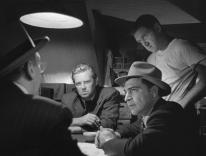The unanimous critical approval greeting Sideways has created some surprising Best Picture buzz—surprising, because Oscar rarely smiles on small movies with loser protagonists. But, if any director can break this unspoken rule, it might well be Alexander Payne, the poet laureate of American losers. Payne’s first three movies depicted the flailings of some of recent American cinema’s most pitiful protagonists. Citizen Ruth gave us an unwed pregnant woman arrested for inhaling patio sealant. Election chronicled the travails of a milquetoast high-school civics teacher traduced by a sexy and ambitious girl. And About Schmidt followed a widowed insurance salesman whose daughter marries into a family of dimwits.
One of the pleasures of About Schmidt was watching iconic rebel Jack Nicholson get put through the grinder of Payne’s nebbish machine. In Sideways, Payne doesn’t have to work nearly as hard, since his leading loser is played by Paul Giamatti, an actor who sends the Geeker Counter into seismic overload. Giamatti (last seen as the genius-schlemiel cartoonist in American Splendor) plays Miles, a would-be novelist living in San Diego. Miles has hit forty, with no publisher interested in his massive autobiographical opus; and as the fantasy of writing fame recedes, he’s left amid the ugly detritus of his real life: divorce, bills he can’t pay, a beat-up car and tiny apartment, and a job—teaching middle-school English—that he hates.
Sideways offers an excruciating and hilarious anatomy of midlife male failure. Payne sends Miles off on a five-day drive through California’s Santa Inez Valley—a bachelor road party with his old college roommate, Jack, who is set to marry at week’s end. An aging soap-opera actor, Jack has hit a brick wall in his career (his latest gig is a commercial for Spray ’n’ Wash), and is counting on his wealthy prospective father-in-law for a job. His former good looks have coarsened, and he knows it; he’s the kind of vain forty-something guy who wears loose shirts to cover the flab, and who in his vacuous enthusiasm still sounds like a seventeen-year-old. “What is this morose bullshit?” he scolds Miles during an evening out with Maya (Virginia Madsen) and Stephanie (Sandra Oh), two women they’ve met in town. “These girls, they want to party.” But while Jack chases the women, Miles focuses on the wine.
Because Miles, it turns out, is a raging oenophile, a wine snob of the highest order. When Jack casually remarks, “I thought you didn’t like Chardonnay,” the hapless nerd becomes a walking, talking encyclopedia of viticultural expertise. “I do like Chardonnay,” he insists. “I just don’t like the way they manipulate it in California. There’s too much oak and secondary malolactic fermentation.” Like a magic elixir, wine brings out in Miles the man of confident judgments. “Quaffable,” he opines over a glass of Pinot Noir. “But far from transcendent.”
Wine snobbery provides a broad target for satire, and Sideways hits it with scenes that are laugh-out-loud funny. When Miles participates in a wine tasting, he shoves his nose deep within the glass, inhaling ardently while for some reason rubbing his ear; it’s as if he is listening to the wine. “Asparagus,” he pronounces solemnly, “and just a...a flutter of Edam cheese.” Later on, Miles and the equally introverted Maya flirt by complimenting each other on their discriminating wine palates, and when Maya makes a tremulous move for intimacy—“Miles, can I ask you a personal question?”—the question turns out to be “Why are you so into Pinot?” Payne has endless fun with such pretensions. Big stretches of the movie look like bad wine commercials: couples laughing around dinner tables or cavorting through misty sunshine in the countryside, grapes glistening on the vine. Rolfe Kent’s sunny up-tempo soundtrack bubbles ironically along, its sixties Italian jazz the quintessence of carefree. You keep expecting Marcello Mastroianni; but instead, what you get is Miles, an angst-ridden nebbish, and Jack, a pathological philanderer. Sideways records the collision between the good life and two men pathetically incapable of living it.
Payne and his regular collaborator, screenwriter Jim Taylor, aren’t simply making fun of the Napa weltanschauung, however. Yes, wine talk is precious and ridiculous. But it is also poetic—animated, Payne insists, by the same impulses that animate poetry, love, and all other crazed passions. Miles hates talking about his novel, because it makes him feel like a fraud; but when he starts talking wine, his self-consciousness vanishes entirely, leaving him free to ruminate—on wines, the cosmos, and the meaning of life. He’s a wine snob; but his kind of snobbishness, Sideways convinces us, is actually the opposite of phoniness. Only when he’s being a snob is Miles authentic.
This paradox turns Sideways into more than a larky satire. Somewhat daringly, Payne and Taylor make the earnest moments of their movie hinge on precisely the same material as its satiric and comic moments. When Miles sighs over his ex-wife, whom he still loves, and says, “She has the best palate of any woman I’ve ever known,” his emotion is being taken seriously. Sideways both skewers and celebrates, with a tonal ambivalence that is Payne’s trademark. His earlier films left viewers uncertain whether he was embracing his protagonists or mocking them, even humiliating them. It was as if Payne was pursuing an argument with himself about his deep intentions—or perhaps with his screenwriter, Jim Taylor. Well, this time they have worked it out, catching the perfect balance of irony and affection that has eluded them in the past.
Sideways has a literary feel; like other small films of recent years, such as In the Bedroom and You Can Count on Me, it puts the emphasis on character. And character, as Payne has commented in interviews, “is all about the details.” We see Miles reading while eating alone in a garish and empty Chinese restaurant; reading on the toilet in his cluttered apartment; even doing the crossword puzzle as he drives—propping it across the steering wheel. Payne makes you realize how lonely reading can be. Such particular, sympathetic accuracies are a way to rescue character from caricature.
Giamatti’s dead-on performance helps immensely. His active face flashes with bitterness, glee, self-loathing, dread, and even fleeting joy, while physically he creates a complex orchestration of nervous habits and tics—for instance, crossing and then uncrossing his arms in sheer nervousness when Maya approaches in a restaurant to say hello. And though Jack’s role verges on cartoon, Thomas Haden Church nevertheless pegs a particularly American (some would say particularly Californian) variety of affable, ex-surfer-boy narcissism. There is something ruefully cautionary for all men in the fates these two guys represent, their egregious flaws of character.
Of course, there are viable alternatives to becoming Jack and Miles, or any of the other figures in Alexander Payne’s gallery of failures. Whole swaths of American life—where people find the right mix of dreaming and doing, where families function and careers afford a modicum of fulfillment—remain well off Payne’s map. It will be interesting to see what happens if he ever decides to go there. In the meantime, he seems to have learned something not particularly technical about how to operate as a filmmaker in Loserland. Right at the point where his other movies grind their protagonists into terminal despair, his new film goes in a different direction—goes sideways, if you will, allowing its schlubby Everyman a sudden, sweet chance at redemption. It’s nice to watch a young director develop a style; but even nicer to see one already blessed with style develop a heart.
Few American directors can rival the productive longevity of Mike Nichols, whose resumé—from Who’s Afraid of Virginia Woolf? and The Graduate to Primary Colors and Angels in America—boasts four decades of superbly workmanlike success, a career and sensibility marked by an almost-too-unerring sense of what audiences want. Nichols’s new film, Closer, arrives hailed as Who’s Afraid of Virginia Woolf? for today. Like the 1966 film, Closer originated in the theater, its script penned by the playwright, Patrick Marber, and it too elicits fine performances from a quartet of actors (Julia Roberts, Natalie Portman, Jude Law, and most impressively Clive Owen), playing two couples in a raucous dance of shifting desires and alliances. Closer also aims at the earlier film’s vertiginous psychosexual atmosphere—the erotic anger that expresses itself in scathing talk, cruel one-upmanship, and a relentless digging into sexual secrets. And the results, at least on the surface, are similarly pitiless.
But the more things remain the same, the more they change. Closer is not set in the suffocating uniformity of a 1950s American college town, but in the cosmopolitan London of today, where anything goes. Nichols’s new movie gives us Internet sex chat rooms and futuristic strip clubs, a level of blank sexual openness—not only among the characters, but also between writer and audience-that makes almost nothing unsayable. The marital warfare enacted by Richard Burton and Elizabeth Taylor’s characters, however, depended for its full effect on some things being generally considered quite unsayable. Who’s Afraid of Virginia Woolf? generated its power from within another era’s far more enclosed conception of marriage (no escape hatch) and of community, with its comprehensive pressure to conform. In a far more decorous era, the film’s clawing, wounding rages conveyed a frightening, revelatory honesty; watching it was like peering in on someone else’s therapy—and shuddering to wonder what might come out in your own. Well, by now it’s 2004, and you probably know; you’ve gotten used to a whole lot of other stuff, too. Closer suffers from the evaporation of a propriety that cannot be recreated. Once the lid is off, the pot will never again boil quite so fiercely.
Please email comments to [email protected] and join the conversation on our Facebook page.
Previous Story
SLOWLY BY SLOWLY
Next Story
Prisoner of the Vatican


